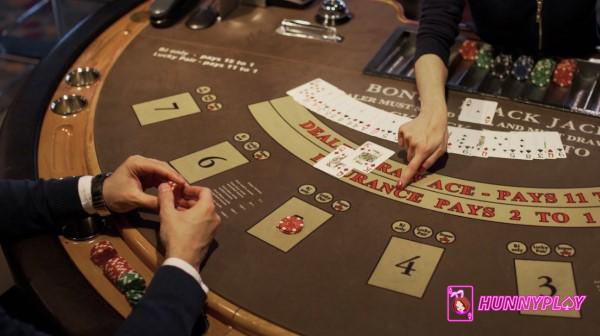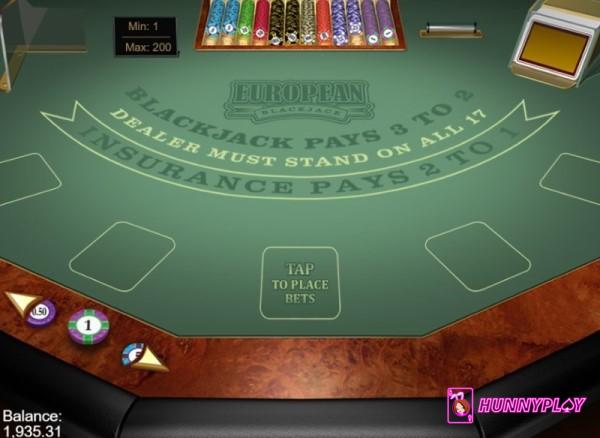With distinct variations from standard Blackjack, European Blackjack offers an authentic reflection of its gameplay in European land-based casinos. In this article, HunnyPlay delves into everything you need to know, from game rules and strategic differences to winning strategies and payout structures.
Origin of European Blackjack
The origin of European Blackjack can be traced back to the 17th century in France, where it was first introduced as a card game named Vingt-en-Un, meaning twenty-one.
This game quickly integrated into European social life and was eventually brought to North America by French colonists in the 18th century.
Initially gaining traction in the legal gambling halls of New Orleans, Blackjack spread rapidly across America. Its popularity soared in Nevada during the 20th-century casino boom, making it a staple in both land-based and online casinos.
Local adaptations led to various game versions, sparking debates among gamblers about American vs. European Blackjack.
This review examines the rules of each game, compares the variations, and highlights the pros and cons to help you determine the best fit for your strategy.
Today, with the advent of mobile casinos, you can enjoy Blackjack anytime, anywhere. This guide aims to enhance your understanding and improve your gameplay, whether you prefer American or European versions.

European Blackjack is a gambling game with a long history and is still very popular today. (Source: Internet)
How is European Blackjack different from other Blackjack games?
European Blackjack is a popular variant of the classic blackjack game, offering unique twists that distinguish it from other versions. One of the key differences is the dealer’s approach to dealing cards.
In this game, the dealer receives only one card face up at the beginning and waits until players have made their decisions before drawing the second card.
Another significant distinction is the lack of a hole card. The dealer in this Blackjack game only reveals the second card after all players have acted. This can affect strategy, especially when players are considering doubling down or splitting.
Doubling down in European Blackjack is also more restrictive. Players can only double down on hands with a total of 9, 10, or 11. This limitation requires a more calculated approach to maximize potential winnings.
Splitting pairs in this Blackjack game follows stricter rules. Players can only split once, resulting in a maximum of two hands.
Additionally, aces can only be split once, and no further cards are dealt to split aces. This rule emphasizes strategic play and careful decision-making.
This game typically uses fewer decks than others Blackjack counterpart. It is commonly played with two to four decks, reducing the house edge slightly and making card counting more feasible for skilled players.
The payout for a natural blackjack in European Blackjack is usually 3:2, which aligns with the standard payout in most blackjack variants. However, it’s crucial to confirm this payout with the specific casino, as variations can exist.

Dealer’s up card in European Blackjack (Source: Play Jojo)
European Blackjack rules
The goal in this game is to achieve a hand value higher than the dealer’s without exceeding 21. While the objective remains consistent with other variations, several unique rules set it apart from its American counterpart.
Key rules for European Blackjack:
Number of decks: Only two decks of cards are used.
Payouts:
- Blackjack: Pays 3:2 (1.5 times the stake plus your stake).
- Insurance Bet: Pays 2:1 (if taken correctly against the dealer getting Blackjack).
- Push: In the event of a tie, the stake is returned (1:1 payout).
Dealer rules:
- The dealer does not have a hole card and therefore does not peak for Blackjack.
- The dealer must stand on a soft 17.
- The dealer must hit on a hand value of 16.
- The dealer’s Blackjack always wins over a player’s hand totaling 21.
- If both the player and dealer have Blackjack, it is considered a push, and bets are returned.
Player options:
- Players can double down only on a hard hand of 9, 10, or 11.
- Players can split a hand only once.
- Players cannot split different 4, 5, or 10-value cards.
- Players cannot double down on a split hand.
- Players cannot surrender if the dealer’s face card is an Ace.
In European Blackjack, players must adapt their strategies to account for the specific regulations. The distinct rules of this variation significantly contribute to its unique strategic aspects, setting it apart from other variations of the game.

Illustrate a online Europe Blackjack table (Source: Internet)
How to play Blackjack
Step 1: Understand the objective
- The goal is to beat the dealer’s hand without exceeding 21.
- Face cards are worth 10, aces can be 1 or 11, and other cards hold their face value.
Step 2: Place your bet
- Place your bet to start the game.
- The dealer then gives two cards to each player and two to themselves.
Step 3: Assess your hand
- Your cards are face up, while the dealer has one card face up and one face down.
- If you have an ace and a ten-value card, you have a blackjack and win 1.5 times your bet, unless the dealer also has blackjack, resulting in a push.
Step 4: Decide your next move
- If you don’t have a blackjack, choose to “hit” (take another card) or “stand” (keep your current hand).
- You can hit as many times as needed but bust if you exceed 21.
Step 5: Explore other options
- If you have a pair, you can “split” them into two separate hands with an additional bet.
- You can “double down” by doubling your bet and receiving only one more card.
Step 6: Dealer reveals their hand
- After all players have acted, the dealer reveals their face-down card.
- The dealer must hit until their hand totals 17 or higher. If the dealer busts, all remaining players win.
Step 7: Compare hands
- Compare your hand to the dealer’s. If your total is higher without busting, you win.
- If the dealer’s hand is higher or you bust, you lose. If it’s a tie, you get your bet back.
Understanding these steps helps you play confidently and make informed decisions at the table. Practice these basics to enhance your enjoyment and improve your chances of winning.
European Blackjack strategy
3 simplified rules
Mastering the advanced strategy of this game can be time-consuming, but starting with some simple rules can greatly improve your gameplay.
- Stand on 17 or More: A hand totaling 17 or more is strong. Make the dealer work to beat it.
- Hit 16 or Less Against a 7 or Higher: The dealer is likely to make a hand with a 7 or higher showing, so you need to improve your hand too.
- Stand on 12 or More Against a 6 or Less: The dealer is more likely to bust with a low card, so avoid risking your hand.
Most of your advantage in Blackjack comes from knowing when to hit or stand, or getting lucky with a Blackjack.
To truly excel, you should also learn the finer points of doubling down and splitting pairs. This is where a basic Blackjack strategy chart becomes invaluable. Using this chart will help you make optimal decisions in more complex situations, enhancing your overall performance at the table.
Additional strategies
Your approach to European Blackjack should adapt based on its unique rules and nuances. Online casino enthusiasts should consider the following strategies to enhance their gameplay:
- Play cautiously: While this Blackjack variation offers a house edge similar to other variants, the rule differences favor players who are cautious and strategic about when and how much they bet. Avoid impulsive betting and carefully consider each move.
- Think carefully about splitting and doubling: In this game, decisions on splitting and doubling require extra thought. If you have a strong hand, such as two Aces, splitting might be beneficial. However, always assess the dealer’s face-up card, as it could indicate a potential Blackjack.
- Insurance is still a bad bet: Despite its appeal, insurance bets are generally unfavorable. Experts agree that insurance rarely pays off, making it an unwise choice in it, just as in other variants.
- Give a strategy a go: Memorizing strategy charts can significantly improve your decision-making process in this game. When playing in a land-based casino, card counting is another effective, albeit riskier, method to increase your odds of winning. However, always practice discretion and adhere to casino rules regarding card counting.
Adapting these strategies will help you navigate the nuances of European Blackjack, increasing your chances of success and making your gaming experience more enjoyable and rewarding.

Applying strategies skillfully helps you increase your chances of winning. (Source: Internet)
European Blackjack tips
Spending hours on European Blackjack strategy charts is valuable, but here are some quick tips to elevate your game instantly:
- Don’t guess: If you’re unsure of the right move, refer to the strategy chart. This approach ensures you make informed decisions and gradually improve your knowledge and skills.
- Practice for free: Many online casinos like HunnlyPlay offer demo versions of this game. Use these free tables to practice and hone your skills without risking money. This way, you can build confidence and refine your strategies.
- Bet smart: Avoid complicated betting systems like the Martingale. Stick to consistent bet sizes, but if you prefer variability, bet smaller when losing and larger when winning. Explore different strategies, but always bet responsibly.
European Blackjack FAQs
Q: How is European Blackjack different?
A: In this game, the dealer receives only one card initially. The second card is dealt after the players have made their moves.
Q: What is the house edge in European Blackjack?
A: This kind of Blackjack has a slightly higher house edge, 0.05% more than American Blackjack, totaling 0.40%. Compared to bets in slots, roulette, or craps, this is still quite low.
Q: How many decks are used in European Blackjack?
A: It typically uses one to eight decks. The dealer does not have a hole card and cannot peak. Additionally, the options for doubling down and splitting are limited.
Conclusion
European Blackjack offers a unique and engaging twist on the classic game with its distinct rules and strategies.
Understanding the differences, such as the absence of a hole card and specific doubling down rules, can enhance your gameplay and increase your chances of winning.
By practicing these strategies and staying informed, you can master and enjoy a rewarding experience. For the best online Blackjack experience, visit HunnyPlay today.




















